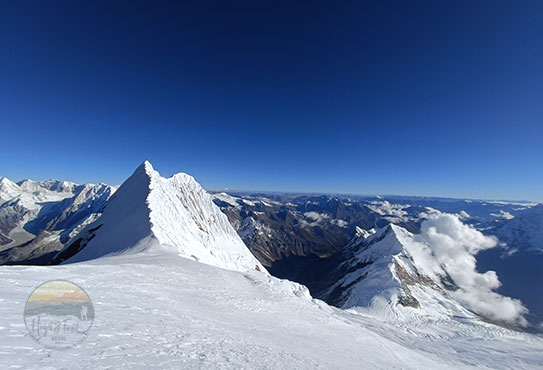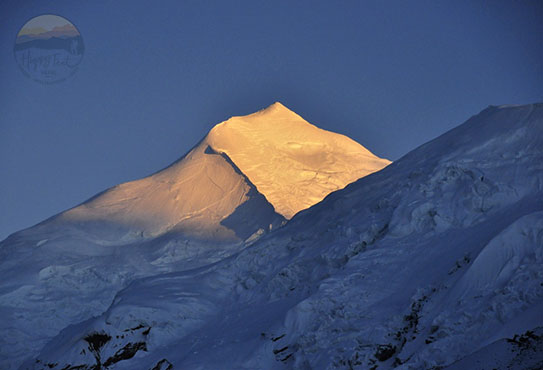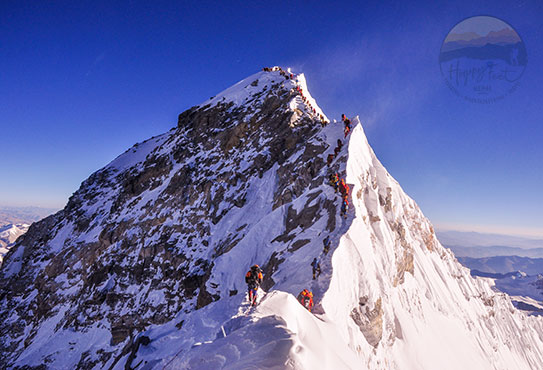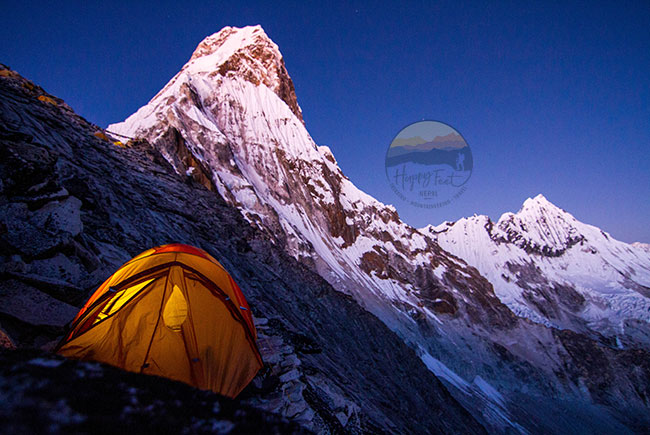-
Sunday - Friday: 9 AM - 4 PM
Mount Manaslu, 8163m above sea level, the eighth highest mountain in the world, is located in the Mansiri Himalayan Range of Nepal in the west-central part of the country. Mount Manaslu was first climbed on the 9th of May in 1956 by a Japanese expedition, which made it one of the favourite mountains of Japanese climbers; after that, this mountain has always been a Japanese mountain.
Mount Manaslu is the dominating peak in the Lamjung District, and it stands to the rivalry of Mount Annapurna forty miles away to the east.
Apart from climbing Mount Manaslu, the Manaslu Circuit trekking trail is popular among trekkers. The permanent snow line remains above 5,000 metres. The lower valley is rich with exclusive types of dominant forests fed by snow and regular rains from June to September. The entire region is declared the Manaslu Conservation Area as the Annapurna Conservation Area to the west of Manaslu and well protected. The Manaslu region is a sanctuary for many endangered Himalayan wildlife, including Pandas and over 110 species of birds, 33 mammals, 11 butterflies and reptiles. The Manaslu Conservation Area is an important habitat for the snow leopard, grey wolf, musk deer, blue sheep and the Himalayan Tahr. Gurung, Chumbas and Nupripas mainly inhabit the area, the Mongolian tribes practising Buddhism.
Arrive in Kathmandu, customs and immigration formalities and claim your baggage, which takes some time. Upon exiting, the arrivals get a traditional welcome from the Happy Feet Nepal representative and transfer to the hotel. Reach the hotel and the rest of the day is free with the possibility of optional excursions (not included), but you can ask to organise any of the tours or stroll through its vibrant streets.
Kathmandu, the capital and heart of the country with three medieval cities, symbolises Nepal’s everything. Having lived through the several ruling dynasties of Buddhists and Hindus, the culture and society of Kathmandu Valley have evolved through time to give it more than a unique feature. Today it is an urban city, and still rapidly increasing, that has its ancient myths and, at the same time, is testimony to the greatness of people who have lived there for time immemorial.
Breakfast at the hotel. In the morning, visit Swayambhunath on a lovely little hill in the northwest city centre, the most sacred site for Buddhists. The self-originated shrine is believed to have been built in its current form around 250 BC. The stupa, painted with a pair of the Buddha’s all-seeing eyes, stands on a lotus mandala base on all four sides. The site offers a complete view of Kathmandu Valley, its surroundings, and the northeast Himalayas.
In continuity, drive to Patan, one of the three medieval cities of Kathmandu Valley and one of the World Heritage sites among the seven World Heritage sites of Kathmandu Valley, located 7 kilometres southwest of Kathmandu. The city known as Lalitpur, the City of Arts, was a renowned Buddhist centre in Asia. There are four Ashok-built Stupas and many miniature stupas, monasteries, viharas and temples. At Patan, we visit its Durbar Square, the Golden Temple, Thousand Buddha, and its museum, among other sites, which explain Buddhism and Hinduism in extensive labels within the living traditions and context.
In the evening, visit the Durbar Square of Kathmandu, an example of the urban architecture of the Malla dynasty with 19-storey buildings, temples and palaces, and the residence of the living goddess Kumari. Kathmandu Durbar Square, the old palace complex that exhibits a mass of temples and palaces, including the Gaddi Baithak Durbar, constructed in 1908, the Basantapur Durbar, or the old Royal Palace, and the Kumari Chowk or the residence of the Living Goddess. Basantapur is amongst the most attractive sites in the bustling centre of Kathmandu. A Western traveller around two hundred years ago wrote that there were more temples than houses and idols than people in its city. Lying in the heart of Kathmandu, Kathmandu Durbar Square is a UNESCO World Heritage Site and not to miss site. The individual building, palaces, and temples have intricately carved doors, lattice windows, and struts full of mythic and erotic figures.
We finalise with the tour and ride a rickshaw and roll through its old city market centre, the Ason Bazaar, seeing what the Nepalese people buy and sell in their daily run.
An 8-hour drive.
The trip begins with an exciting overland journey to reach Nepal Mid West, heading past Besisahar town, the headquarters of Lamjung district. From Besisahar, we change the vehicle to a Jeep and drive on a dirt road past Khudi, Bulbule, Ngadi, Syange, and Chemche and to Tal Besi village, following Masrsyangdi River upstream. The drive takes us through terraced fields and deep river valleys with different views. Tal Besi is a beautiful place for an overnight stop, with several good lodges and a beautiful waterfall.
From Tal Besi, the trail follows the Marshyangdi valley upstream through a narrow gorge crossing several dispersed settlements and beautiful waterfalls and reaching Khotro. Shortly after, cross a suspension bridge and trek uphill to Nache village. Nache is a Gurung village and sits high above the Marshyangdi River. The Nache village is prosperous, with a large cultivating field. Have a refreshing rest, see around, and cross another suspension bridge and beautiful walk through the pine forest traversing Tilche, another big village, on the Dudh Khola (Milky River) bank.
A 5-hour trek.
Register your mountaineering, trekking and Manaslu conservation area entry permits, initiate the trek following the Dudh Khola (Milky River) valley, and walk on a newly opened wide track. Then continue a lovely walk in nature and reach Gowa, on a river junction. Gowa is a small village of the Gurung community with a large fertile land fed by Dudh Khola and developing into an excellent overnight place with some lodging facilities; stop for a refreshing drink and rest. Then a short trek to Suti Khola and stop for a hearty lunch and rest, enjoying a beautiful walk in the Himalayan nature. The afternoon requires about a 3-hour hike to reach the Yak Kharka (Yak Shed) amidst a beautiful rhododendron forest. If you trek here during spring, the area until Bemathang (Bhimthang) is one of the rhododendron sanctuaries of Nepal to earn a lifetime memory.
A 6 hours excursion.
Enjoy a leisurely wake-up and have breakfast. Then, we take a beautiful day excursion to Manaslu Base Camp, which takes about 6 hours to go and return with a packed lunch. After about an hour’s walk from Yak Kharka, through a dense rhododendron forest, we leave the main trail to Bemathang, cross a river, follow the Purdi River for about another, and reach Manaslu Base Camp. The site offers 360 degrees views, including the northwest face and spur of Manaslu, Peak-29 of 7,871 metres and Pungi Himal of 6,538 metres.
A 5-hour trek.
Another leisurely day. Enjoy a leisurely wake-up and have breakfast. Then, retrace the same trail we took yesterday to hike up to Manaslu Base Camp for an hour. The forest ambience at this altitude is lovely. The picturesque Bhimthang (original name is Bemathang, which means the meadow of Sand in the Tibetan/Nupripa language), at 3520m., is a lovely place lying on a vast green valley with several good lodges adorned with prayer flags and a view of looming Manaslu. The area surrounded by Himalayan Juniper, tall green rhododendron, pines, and the oak forest is one of the famous rhododendron sanctuaries in Nepal. The significant views from here are the northeast face of Mount Manaslu, the south face of Pungi Hima, and Cheo Himal.
An essential acclimatising or resting day complemented with a beautiful place. After breakfast, take a short hike to Ponkkar and Nayamlo Tso in the morning and enjoy the beautiful scenery of vast glaciers fed by Kang Guru, Gyaji Kang 7100m., Nemjung Himal 7140m., Himjung Himal and HimlungHimal 7126m. The two big glacial lakes, Ponkkar and Nayamlo Tso, lie between the Pongkar and Salpudanda glaciers. These two glaciers join the main glacier and form the Salpudanda Glacier, whose lateral moraine beautifully towers over Bhimthang (Bemathang). Enjoy a lovely exploratory excursion vast into the Himalayan glaciers and return to Bemathang for a history-telling overnight rest.
An 8-hour trek.
The morning starts with a gradual going up, passing some rocky lateral moraine. The views to the northwest toward the Salpudanda Glacier with Ponkhar Lake, icefalls and mountains in every direction are impressive. As the valley narrows, the trail ascends to Larke La through some sections of scree, snow and ice, the pure nature of the Himalayas. The top of Larke La is adorned with thousands of colourful Buddhist prayer flags, and the significant views are of Himlung Himal, Cheo Himal, Kang Guru and Annapurna II, Larke Peaks, and other peaks. The trail then makes a long descent to Larke Phedi through the moraine of rocks and boulders, enjoying the grand scenery of a new and beautiful valley welcoming us. As we near the north of Larke Glacier, from Cho Danda, the views of Larke Peak, clear glacier, beautiful valleys of Manaslu, glacial lakes and a range of Himalayan fauna and flora are beautifully seen. Then a short descent to Lapke Phedi, also known as Dharmasala (travellers’ rest house/shade).
Larke Phedi, or the Larke Bazaar, is a ruined town, but still known as Larke Bazar or an old fairground. In the past, the Tibetans, Nepalese and Sherpas from Namche Bazar (Everest Zone) came here for trade, giving this place a famous name.
A 5-hour trek.
Beautiful trekking, walking down to Samdo village, the last uppermost village of the Manaslu valley. The trail crosses two icy streams and a wooden bridge and reaches Samdo, enjoying incredible views of the snow-capped peaks of Manaslu; for locals, Manaslu is Kutang Kang. The afternoon trek is 3 hour walk and starts with a steep descent to Budi Gandaki River, crossing a wooden bridge, and reaching Yak Herders’ Sheds at Kermo Kharka. Next, pass Himalayan Juniper bushes, Birch forest, and several mani-walls with thousands of Buddhist mantra-carved stones until we reach Sama Gaon. The views in all directions are indescribable.
Sama Gaon is one of the largest villages in this region. The inhabitants are mostly farmers who grow what they can in this rough terrain and cold climate, but the main ones are buckwheat, wheat, barley, potatoes, and some vegetables. The locals reach the border with Tibet in one day. It is one of the ancient salt trade routes between Nepal and Tibet. People around the upper Manaslu valley are descendants of southwest Tibet, way back more than 2000 years. The custom and culture are no less similar to Tibetan predecessors.
A 4-hour trek.
Take a leisurely breakfast and walk to our prime destination, the Manaslu Base Camp, from where the ascent begins to the Summit of Mout Manaslu. On the way, we see the peaceful Birendra Lake and arrive at Manaslu Base Camp for a hearty lunch. The Manaslu base camp, with beautiful views of the Himalayas, lies on a rocky moraine like most mountaineering base camps. The base camp gets established before climbing members arrive; therefore, you get a warm welcome from your climbing Sherpas and basecamp staff with a warm cup of juice/hot beverages followed by snacks. Then, get assigned to your tent and hand over your duffel bags with climbing gear—lunch and rest.
The Puja ceremony at the Manaslu Base Camp gets prioritised to allow the climbing Sherpa guides to fix the higher camps and routes and to deposit the essential climbing material, meals and oxygen in the respective camps. The puja ritual is to solicit the local deities for peaceful and obstacle-free climbing permission.
A 3-hour trek.
Leisurely wake up and have breakfast. Farewell hugs to your climbing sherpa guides and kitchen staff, and fellow climbers, and retrace back to Sama Gaon. Arrive for lunch and get checked into a lodge. The rest of the day is free on your own—if you wish for a local walk or visit, your guide will always be around you, so just let him know.
A leisurely wake, have breakfast and prepare for a short and panoramic flight to Kathmandu. The Helicopter arrives – enjoys a short and scenic flight to Kathmandu. Upon landing, the representative of Happy Feet Nepal will welcome you back and transfer you to your hotels. Get distributed to the rooms, and the rest of the day is free.
The expedition team leader must visit the tourism ministry to sign the related document. Other members are free to do their last-day activities. The evening gets dedicated to a farewell dinner in one of the celebrative restaurants of Kathmandu.
The Representative of Happy Feet Nepal will arrive at your hotel with transport three hours before your departure flight time. Get escorted from the hotel to the International Departure Terminal, see off formalities, and go through the immigration and departure.



